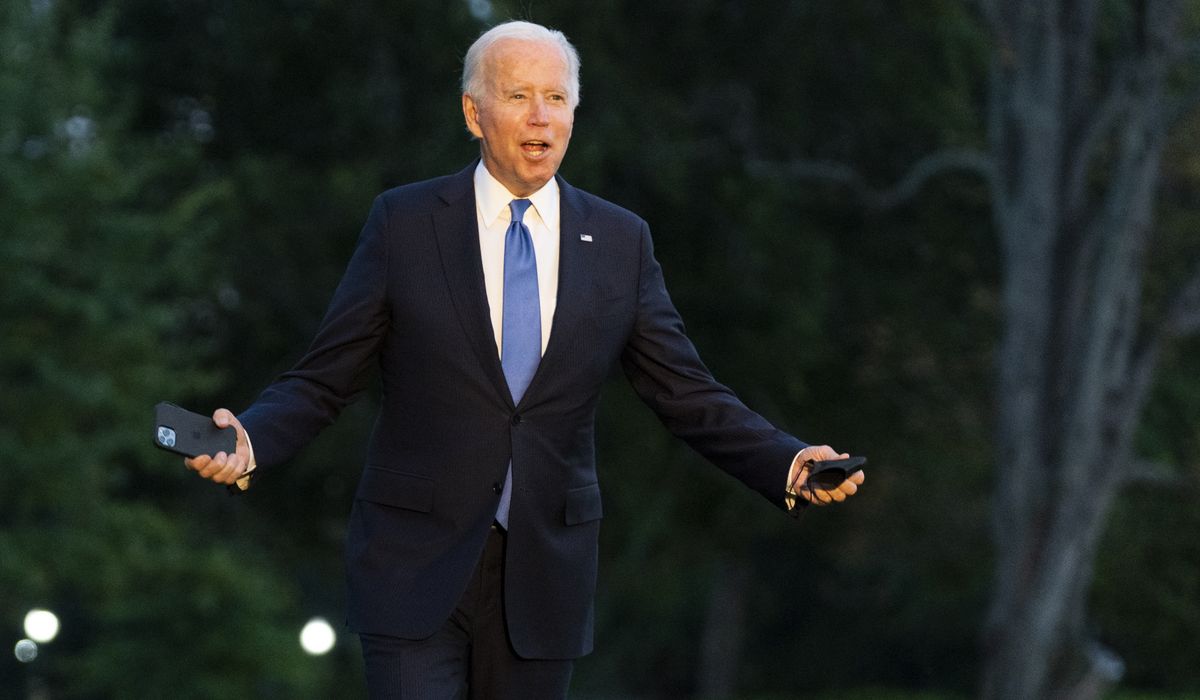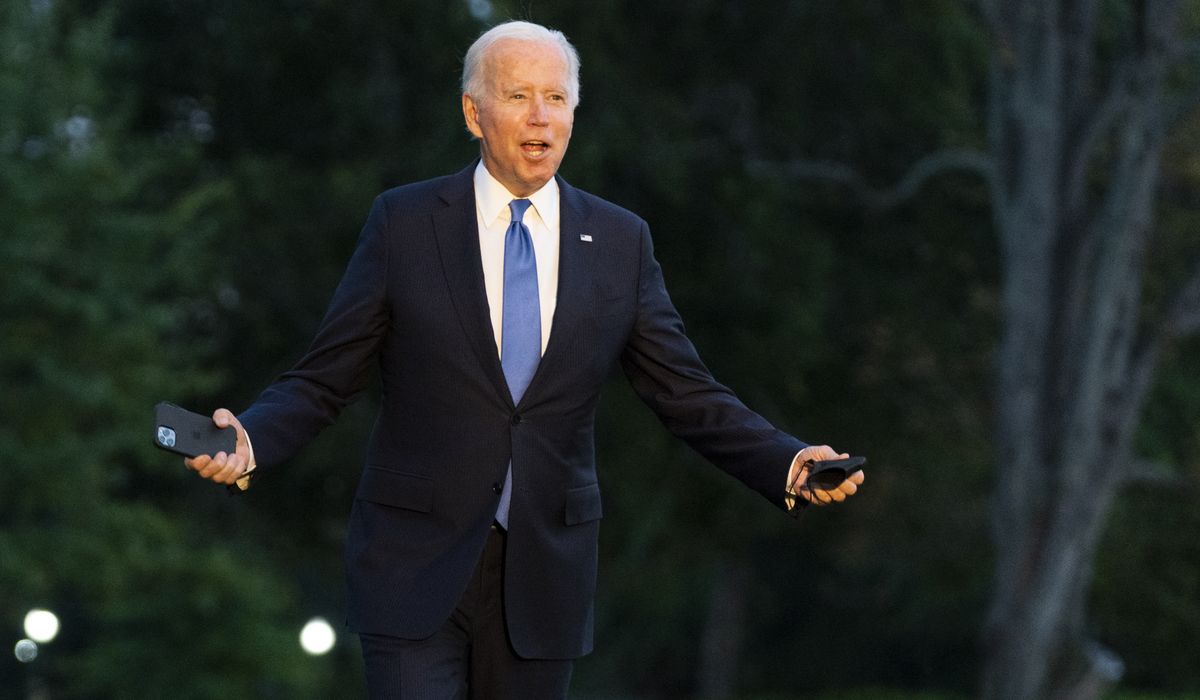
U.S. employers are still struggling to find workers six weeks after enhanced federal jobless benefits expired, but that doesn’t mean Republicans are letting President Biden off the hook.
The National Federation of Independent Business reported last week that a record 51% of small-business owners had openings in September that they could not fill, a 48-year high, even though the boost in unemployment benefits ended on Labor Day. The shortage indicates that other factors are at play.
Among them are a rash of accelerated retirements, a soaring personal savings rate, ongoing coronavirus fears and unsettled child care and schooling situations. Mr. Biden is coming under fire for vaccine mandates and juiced social welfare payments that go beyond the now-defunct Pandemic Unemployment Assistance relief.
“That’s not the only thing that they added. They added a number of other welfare programs, and they got rid of the welfare-to-work requirements,” House Minority Whip Steve Scalise, Louisiana Republican, said Oct. 10 on “Fox News Sunday.”
Those benefits included a July increase in the annual child tax credit from $2,000 per child to $3,600 for every child younger than 6 and $3,000 for older children — with no work requirement — and raising the cutoff age from 16 to 17.
The Department of Agriculture’s unprecedented 25% permanent increase in food stamp benefits took effect on Oct. 1. The administration also has sought to reverse President Trump’s rule allowing states to implement work mandates for Medicaid recipients.
Mr. Biden has imposed COVID-19 vaccine requirements for federal workers, contractors and companies with more than 100 employees. That mandate has resulted in more vaccinations, but also reports of thousands of workers quitting, being suspended or getting fired.
“It wasn’t just one thing. It was many things, and they’re all lining up and catching up with this economy,” Mr. Scalise said. “And again, he could reverse it right now, but he doesn’t want to. They keep doubling down on this far-left socialist agenda.”
Pushing back was Transportation Secretary Pete Buttigieg, who said the idea that enhanced federal jobless benefits were keeping people home was “freshly disproven.”
“A lot of those benefits ran out, and we did not see the kind of effects of people rushing to return to work that you had a lot of those commentators confidently predicting just a few weeks or months ago,” Mr. Buttigieg said Friday on Fox News. “So I think what this shows is there are deeper issues.”
Mohamed El-Erian, the chief economic adviser at Allianz, agreed with that analysis. “What’s clear is that the expiration of the benefit has not led to more people coming into the labor force,” he said.
“So that issue has been sorted out,” he said. “What’s not clear is what’s keeping labor from coming in.”
Permanently unemployed on the rise
Analysts agree that the COVID-19 pandemic has triggered a social and economic chain reaction that caused about 5 million people to drop out of the workforce for a variety of reasons, in some cases for good.
“We’re down about 3 million workers from pre-pandemic, and this is people who aren’t even looking for work,” said Marc Weinstein, a human resources management professor at Florida International University. “So why do they exit?”
Some of them retire. An analysis released last month by The New School’s Schwartz Center for Economic Policy Analysis found at least 1.7 million more than expected joined the ranks of the retired during the pandemic.
The economy added 194,000 jobs in September, but the net gain was all men. About 220,000 men started jobs and 26,000 women left jobs, indicating that ongoing problems with child care availability and a lack of dependable schooling are driving down workforce participation.
The tally of workers quitting rose from 4 million in July to 4.3 million in August, the highest number since December 2000, according to the Labor Department. When people leave their jobs, others quit to fill the newly available posts.
“So if you’re an employer, you have to deal with the fact that not only can you not fill new jobs, but filling vacancies because of this domino effect: I’ve been cooped up in a job I really don’t like, there’s an opportunity now because somebody else left the labor market, and I’m going to use that opportunity to try to get a better job,” Mr. Weinstein said.
Meanwhile, the level of personal savings has surged. Federal stimulus checks gave some Americans the financial cushion they needed to stay home and reevaluate their priorities. The phenomenon is described as the “great reassessment” or “great resignation.”
“Many of these workers may have simply reached a breaking point after months and months of high workloads, hiring freezes, and other pressures, causing them to rethink their work and life goals,” the Harvard Business Review said in a Sept. 15 article.
The U.S. workforce participation rate has been declining slowly but steadily after peaking in 2000, but it fell below 61% at the start of the pandemic in March 2020. Participation climbed to 61.6% in September, still under the 63.3% pre-pandemic level, as reported by the Bureau of Labor Statistics.
The workforce participation rate refers to the percentage of the civilian population either working or actively looking for work.
The September jobs report showed unemployment declining from 5.2% in August to 4.8%. That figure does not, indeed isn’t designed to, account for those who have exited the labor force. Jobless claims fell by 36,000 to 293,000, the smallest number since the pandemic began in March 2020, the Labor Department reported Thursday.
Manhattan Institute fellow Steven Malanga said years of growing U.S. social welfare payments, including unemployment and disability, mean “the ranks of the permanently unemployed have grown in America.”
“More people are getting used to not working, and the Biden administration’s proposals for expanding federal aid programs will do little to lure them back,” Mr. Malanga said in a Friday op-ed in City Journal.
In July, the number of job openings hit a record 10.9 million. The number fell slightly to 10.4 million in August.
“I can’t think of a time in recent history that’s been like this,” said Paige Ouimet, a finance professor at the University of North Carolina at Chapel Hill. “This is a very dramatic labor shortage.”
For employers, the problem is not just a lack of qualified workers but any workers at all, said Holly Wade, executive director of the National Federation of Independent Business.
“Right now, we’re finding more and more that you can’t find anybody applying for these jobs,” Ms. Wade said. “It’s not even finding someone with the qualifications or experience you would have liked; it’s just finding anybody to apply for your positions.”
Desperate businesses have started offering flexible hours, higher wages and bonuses to new hires. Restaurants and retailers have cut hours to juggle limited staff.
In Springfield, Missouri, a billboard posted by local business owners this month didn’t mince words: “Get Off Your Butt! Get. To. Work. Apply Anywhere,” as shown on KMOV-TV.
Massachusetts Gov. Charlie Baker last month mobilized about 250 National Guard members to drive school buses in districts with driver shortages.
The Biden administration last week announced $100 million in funding for the National Health Service Corps to address a shortage of health care workers, whose numbers have fallen by about 524,000 since the start of the pandemic, according to the Bureau of Labor Statistics.
Republicans say the $3.5 trillion social spending package would compound the labor market problem with billions of dollars in programs, including free community college, child care assistance, universal pre-kindergarten, Medicare expansion and an extension of the child tax credit until 2025.
A study released last month by the University of Chicago’s Becker Friedman Institute found that keeping the child tax credit in place would lead 1.5 million workers, or 2.6% of all working parents, to leave the labor force.
Trump administration economic adviser Larry Kudlow called the social spending bill the “largest expansion of the social welfare state since LBJ’s Great Society,” and “none of these programs have a single work requirement.”
Meanwhile, liberals argue that the social spending package would address problems with unaffordable child care that have prevented some Americans from reentering the workforce.
The Build Back Better plan’s provisions on paid family leave, child care and community college “are going to give us a stronger labor force and help us deal with that major constraint on economic growth,” Mr. Buttigieg said Sunday on CNN’s “State of the Union.”
Rep. Alexandria Ocasio-Cortez, a New York Democrat who has introduced legislation to extend the unemployment insurance boost until February, said, “It’s not really a labor shortage. It’s a dignified work shortage. It’s a living wage shortage.”
Rep. Emanuel Cleaver, Missouri Democrat, also disagreed with his Republican colleagues that richer unemployment benefits have disincentivized people from returning to the workplace.
“I think it’s wrong for Americans to call Americans lazy,” Mr. Cleaver said. “There are some lazy people, but it’s not that all of a sudden, after COVID, people decided they were going to be lazy and just didn’t want to work, and they’re getting these big payments from the government when they’re not getting them.”
On the other side is Rep. Kevin Hern, an Oklahoma Republican who brought a bill in May to end the $300-per-week federal unemployment benefits boost and challenged the view that increasing wages is the answer.
“Oklahoma is at $7.25 an hour, the federal minimum wage, yet there are people hiring at $15 an hour, twice the minimum wage, and still can’t get people,” Mr. Hern said.
Rep. Michael T. McCaul, Texas Republican, said unemployment benefits can tempt people to stay out of the workforce.
“If you pay people more to stay home and not work, they’re not incentivized to work if they can stay home and collect benefits,” Mr. McCaul said. “We have jobs. We just have a lot of jobs that we can’t fill.”








